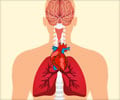Health experts are urging the inclusion of tuberculosis prevention programs in HIV treatment and care, as TB is a major cause of death among HIV patients.
Health experts are urging the inclusion of tuberculosis prevention programs in HIV treatment and care, as TB is a major cause of death among HIV patients.
Dr Diane V. Havlir, of the University of California, San Francisco, and colleagues examined interactions between HIV and TB for HIV care programs and the framework for HIV programs to incorporate TB activities, and global progress in implementation."As HIV care expands further, there is both an opportunity and necessity for incorporation of TB control activities into these programs," wrote the authors.
"Tuberculosis programs simply do not have the capacity to provide ongoing TB screening, prevention, and treatment for millions of individuals receiving HIV care," they added.
The authors said that TB poses numerous challenges to HIV treatment
including drug-resistance, difficulty in diagnosis and treatment in HIV-infected persons and complications from drug interactions.
"Finding and treating TB cases, administering antiretroviral therapy (ART) and isoniazid preventive therapy [IPT; an antibacterial drug], and infection control are critical activities to incorporate into HIV care programs, the first chronic care models to emerge in many developing countries.
Advertisement
The authors suggested several approaches that would help in reducing the TB mortality rate in HIV patients.
Advertisement
Then comes treating Individuals with active TB. The authors suggested expansion of a care model whereby TB is treated by HIV programs. HIV care staff is trained to diagnose and treat a wide array of infections associated with HIV disease.
Allowing Isoniazid Preventive Therapy administration, which in some countries is either against national policy or impossible because of the stringent requirements for the exclusion of TB before IPT initiation would also help in reducing deaths.
Antiretroviral Therapy is one of the most powerful weapons against TB. The earlier ART is initiated, the lesser is the TB risk.
TB Infection Control is one of the most challenging areas. Implementation of measures in both outpatient and inpatient health care facilities that will reduce the risk of TB transmission and protect health care workers is a challenge. TB infection control guidelines exist but are rarely implemented.
It is essential to recording and reporting TB infections. Standardized recording and reporting formats in accordance with national TB and AIDS control guidelines should be used.
Lastly, Joint HIV/TB Planning, the authors suggest that successful implementation of TB interventions in HIV services requires effective communication, coordination, and collaboration with TB control programs.
"HIV care programs must take a bold approach to TB prevention, diagnosis, and treatment to successfully address the catastrophic and intersecting epidemics of HIV and TB," said the authors.
The report appears in the July 23/30 issue of JAMA.
Source-ANI
SRM















